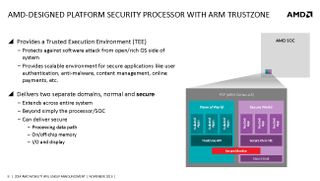AMD APU13: Meet Beema, Mullins, Security Co-Processor
AMD has introduced new low-power APUs at its developer summit.

In a press briefing on Tuesday, AMD's Gabe Gravning, director of marketing for the company's client business, said that the client device market is rapidly changing. In one group, you have the traditional PC ecosystem that's focused on performance, and in the other you'll find consumption devices like tablets and smartphones packing Android and Apple's iOS. All these form factors are colliding, he said, into what the company calls the new client ecosystem, and is the focus of two new APUs being introduced into the roadmap: Beema and Mullins.
These new APUs for the low-power and ultra-low-power space are a follow up to Kabini and Temash. They're full single-chip solution SoCs packed with two or four Puma cores, which is an iteration of the Jaguar cores. They will also continue to have Graphics Core Next graphics (GCN), and he said the company will disclose more about the number of CUs and so on at a later date.

"Clearly we'll have graphics leadership with these APUs," Gravning added. He said that Beema will be in the 10 to 25 watt range, suggesting convertible notebooks, and Mullins will go as low as 2 watts, enabling quad core fanless designs like tablets and convertibles for 2014. He said AMD has achieved a 2x increase in performance per watt with both Mullins and Beema.
These two new APUs will also support Microsoft Connected Standby, otherwise known as InstantGo. "We do have the capability with these products to support Microsoft Connected Standby now, which has a certain level of low power in deep sleep states, additional deeper sleep states. So the advantage of that, whether you implement the full Microsoft Connected Standby or not, is that we can go into deeper sleep and lower power states to extend your battery life when you're in standby." Later on he mentions under 500 ms from standby to resume.

During the briefing, Gravning also revealed an AMD security co-processor. "You've probably seen the news about the partnership we've done with ARM on TrustZone," he said. "Now we incorporate the ARM TrustZone -- it's an ARM Cortex-A5 co-processor – directly in the APU (on die, on chip)."
He said that this on-die security provides a trusted execution environment that runs as a standalone environment from the rest of the system, from the operating system. This is going to enable all sorts of security scenarios, from mobile payments to secure boot to authentication apps to content management. He pointed out that AMD is bringing this mobile/ARM security standard to the x86 world, and that a huge number of infrastructure and applications will now have access to TrustZone for security and authentication.

Form here he talked about the Windows platform, saying that Miracast is the "right horse to bet on" regarding wireless display now that adoption has picked up. "Ultimately, what we want with Miracast is every single TV, panel and projector to have Miracast built in," he said, "so that you don't have to deal with dongles and everything else, and that's starting to happen now. We've bet on Miracast and we have some of the best Miracast technology in the industry with our Direct Encode Mode (DEM) solution that provides lower latency and higher quality. Now with Windows 8.1, it's built right into the user interface."
Stay on the Cutting Edge
Join the experts who read Tom's Hardware for the inside track on enthusiast PC tech news — and have for over 25 years. We'll send breaking news and in-depth reviews of CPUs, GPUs, AI, maker hardware and more straight to your inbox.
Later on in a Q&A, he was unable to answer a question about Miracast drivers for Linux, so stay tuned for that one.
In addition to Miracast, the briefing also talked about Dockport for tablet and notebook solutions, which adds ports back to those form factors by providing display, power and USB over a single cable. He said we'll see cool docking solutions at CES, and things AMD is doing with Dockport and its new Mullins tablets. This tech supports up to four monitors, mouse and keyboard, external HDDs, optical drives, printers and virtually any other device or peripheral that will support the standard.
Finally, he summarized that the Beema and Mullins APU launch won't be a cold one: there may be products introduced alongside the new chips; he mentioned tablets, two-in-one and ultra-thin form factors. The new APUs have the compute power to do graphics intensive workloads and enable surround computing, enable quad core fanless designs, and provide two times the performance per watt than the previous generation in 2013. They're also the first to implement AMD's new security co-processor; Kabini does not have this feature.
Beema and Mullins are expected to arrive in the first half of 2014.
-
tntom Interesting strategy. I wonder if this was the implementation of ARM that was hinted by AMD back in January of 2012?Reply -
battler624 Isn't that the PS4 APU? wow that was a quick release, i remember hearing them saying its their latest and wont release to PC's until 2014...Reply -
ragenalien Reply11931412 said:Isn't that the PS4 APU? wow that was a quick release, i remember hearing them saying its their latest and wont release to PC's until 2014...
Both the PS4 and Xbox one use custom AMD apu's based off the current jaguar cores.
-
sonofliberty08 they r great mobile chips, but we r hardly to find 1 devices that pack the temash or kabini in the market, the manufacturer rather pack the crappy atom into their devicesReply -
InvalidError Reply
With AMD betting the ship on hybrid computing, I think the CPU-only FX series are about to hit the end of the line.11931259 said:This is great and all buuuuttt FX anyone? -
cmartin011 sad the fx is not a priority has to to be keep no less than 15% of performance of intel to make the cake and no less than 10 percent performance (due to stronger gpu) to keep the apu buiness positive.Reply -
cmartin011 sad the fx is not a priority has to to be keep no less than 15% of performance of intel to make the cake and no less than 10 percent performance (due to stronger gpu) to keep the apu buiness positive.Reply -
cmi86 I swear there has to be an FX with ll these leaks of PD APU's, It wouldn't make any sense if there weren't. The question is why won't they talk about it ? Hopefully they are really on to something and are keeping tight lips to drop a bomb soon.Reply -
renz496 Reply11932194 said:I swear there has to be an FX with ll these leaks of PD APU's, It wouldn't make any sense if there weren't. The question is why won't they talk about it ? Hopefully they are really on to something and are keeping tight lips to drop a bomb soon.
Either they were very tight lipped about it or they are going to say good bye forever to the FX processor and become APU only for consumer side.
Most Popular

